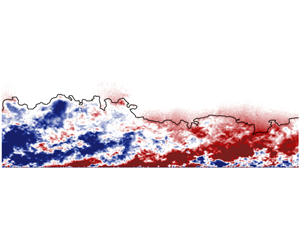Article contents
Effect of the intermittency dynamics on single and multipoint statistics of turbulent boundary layers
Published online by Cambridge University Press: 10 June 2020
Abstract

The instantaneous velocity field of turbulent flows is traditionally described in a statistical sense as a sum of an ensemble or temporal mean velocity at a specific location and a fluctuating term. While the Reynolds decomposition is well-established for fully turbulent flows, its applicability for flows that show intermittent behaviour is questionable. As intermittency is an integral part of turbulent boundary layer and turbulent jet and wake flows, an analysis of the effect of the intermittency on the statistical quantities is of fundamental interest. In this work, the effect of intermittency on single and multipoint statistics is studied for an experimentally obtained turbulent boundary layer data set at high Reynolds numbers by means of three different decomposition approaches. The analysis clearly shows that the Reynolds decomposition is only valid for single point statistics in the inner fully turbulent region of wall-bounded flows. In the wake region of a turbulent boundary layer, the Reynolds decomposition overestimates the turbulent kinetic energy due to the intermittency of the turbulent/non-turbulent interface. It is shown herein that these artefacts can be reduced or even completely avoided by applying either the boundary layer height or zonal based decomposition approach. In this study, the limitations of the different methods are analysed in detail and the approaches are evaluated comparatively by investigating statistical quantities such as turbulence intensity, anisotropy of fluctuations and characteristic length scales of coherent motions. The results make it possible to better understand and interpret the characteristics of the turbulent statistics of intermittent flows.
JFM classification
Information
- Type
- JFM Papers
- Information
- Copyright
- © The Author(s), 2020. Published by Cambridge University Press
References
- 14
- Cited by

